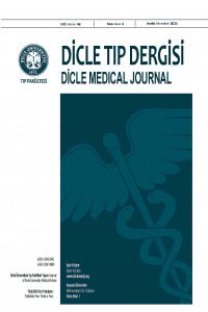Effects of Intragastric Balloon on Body Mass Index, Lipid Profile and Blood Glucose Regulation: A Prospective Study
İntragastrik Balonun Vücut Kitle İndeksi, Lipit Profili ve Kan Şekeri Regülasyonu Üzerine Etkileri: Prospektif Çalışma
___
- 1. Satman I, Omer B, Tutuncu Y, et al; TURDEP-II Study Group. Twelve-year trends in the prevalence and risk fac- tors of diabetes and prediabetes in Turkish adults. Eur J Epidemiol 2013;28:169-180. 2. WHO. Obesity: preventing and managing the global epi- demic. Report of a WHO consultation on obesity. Geneva: World Health Organ Tech Rep Ser. 2000;894:i-xii, 1-253. 3. National Institutes of Health. Clinical guidelines on the identification, evaluation, and treatment of overweight and obesity in adults-the evidence report. National Institutes of Health. Obes Res 1998;6:464. 4. Bays HE. Current and investigational antiobesity agents and obesity therapeutic treatment targets. Obes Res 2004;12:1197-211. 5. Waseem T, Mogensen KM, Lautz DB, et al. Pathophysiology of obesity: why surgery remains the most effective treat- ment. Obes Surg 2007;17:1389-1398. 6. Vrabie CD, Cojocaru M, Waller M, et al. The main histopath- ological gastric lesions in obese patients who underwent sleeve gastrectomy. Dicle Med J 2010;37:97-103. 7. Doldi SB, Micheletto G, Di Prisco F, et al. Intragastric bal- loon in obese patients. Obes Surg 2000;10:578-581. 8. Buzga M, Evzen M, Pavel K, Tomas K, Vladislava Z, Pav- el Z, et al. Effects of the intragastric balloon Medsil® on Weight loss, fat tissue, lipid metabolism, and hormones involved in energy balance. Obes Surg 2014;24:909-915. 9. Genco A, Bruni T, Doldi SB, et al. Bioenterics intragastric Balloon: the Italian experience with 2515 patients. Obes Surg 2005;15:1161-1164. 10. Saruç M, Böler D, Karaarslan M, et al. Intragastric bal- loon treatment of obesity must be combined with bariat- ric surgery: a pilot study in Turkey. Turk J Gastroenterol 2010;21:333-337. 11. Kotzampassi K, Grosomanidis V, Papakostas P, et al. 500 intragastric balloons: What happens 5 years thereafter? Obes Surg 2012;22:896-903. 12. Sekino Y, Imajo K, Sakai E, et al. Time-course of changes of visceral fat area, liver volume and liver fat area during intragastric balloon therapy in Japanese super-obese pa- tients. Intern Med 2011;50:2449-2455. 13. Konopko-Zubrzycka M, Baniukiewicz A, Wroblewski E, et al. The effect of intragastric balloon on plasma ghrelin, leptin, and adiponectin levels in patients with morbid obe- sity. J Clin Endocrinol Metab 2009;94:1644-1649. 14. Crea N, Pata G, Casa DD, et al. Improvement of Metabolic Syndrome following intragastric balloon: 1 year Follow-up Analysis. Obes Surg 2009;19:1084-1088. 15. Forlano R, Ippolito AM, Iacobellis A, et al. Effect of the bioenterics intragastric balloon on weight, insulin resis- tance and liver steatosis in obese patients. Gastrointest En- dosc 2010;71:927-933. 16. Fuller NR, Pearson S, Lau NS, et al. An Intragastric Bal- loon in the Treatment Of Obese Individuals With Metabolic Syndrome: A Randomized Controlled Study. Obesity (Sil- ver Spring) 2013;21:1561-1570. 17. Yasawy MI, Al-Quorain AA, Hussameddin AM. Obe- sity and gastric balloon. J Family Community Med 2014;21:196-199.
- ISSN: 1300-2945
- Yayın Aralığı: 4
- Başlangıç: 1963
- Yayıncı: Cahfer GÜLOĞLU
ÖMER KAYNAR, NURİNNİSA ÖZTÜRK, NURCAN KILIÇ BAYGUTALP, EBUBEKİR BAKAN, FATİH KIYICI
Effect of treatment choice on survival in a case with meningococcemia and multiorgan failure
Kadriye Özdemir, Nida Dincel, Orhan Kara, Ebru Yılmaz, Gözde Gözüoğlu, Sevgi Mir
Carotid Artery Stenting: Retrospective Evaluation of Experience of an Invasive Tertiary Center
Faruk ERTAŞ, Mehmet Çevik, Mehmet Aluçlu, Halit Acet, Hasan Özdemir, Oğuz Karahan, Nihat Polat, Gülsenem Aktaş
Kaudal Epidural Steroid Enjeksiyonu Sonrası Gelişen Nadir Bir Komplikasyon: İnatçı Hıçkırık
Ayhan KAYDU, Erhan DÖKÇEK, Cem Kıvılcım KAÇAR, MAHİR KUYUMCU
The Accuracy of Frozen Section in the Diagnosis of Malignant Adnexal Masses
NURİ YILDIRIM, Alkım Gülşah YILDIRIM ŞAHİNGÖZ, Osman ZEKİOĞLU, Necmettin ÖZDEMİR, Ahmet Mete ERGENOĞLU, Ahmet Özgür YENİEL, M. Coşan TEREK
Göğüs Ağrısı Çocuklardaki Malign Tümörlerin İlk Semptomu Olabilir: İki Olgu Sunumu
Alper AKIN, Meki BİLİCİ, MURAT SÖKER, Bedri ALBUDAK, FATİH METEROĞLU
Evaluation of the Newborn Hearing Screening Test Applied in a Secondary Center
Ayşe ÇAKAL, Zerrin AŞCI, Abdulkadir BUCAK, Beyhan YILMAZ, Emel AYTUĞ
Hematolojik Malignansilerde P-Glikoprotein Ekspresyonunun Akım Sitometri İle Belirlenmesi
Berkay Saraymen, Behzat Çimen, İhsan Çetin, Mustafa Köker, Aysun Çetin, Bülent Eser
The Relationship between Oral Hygiene Index and Gastric Helicobacter Pylori Positivity
Tolga ÖNDER, Turgut Anuk, Cihan HEYBELİ
Atypical Papular Purpuric Eruption Induced by Parvovirus B19 Infection
